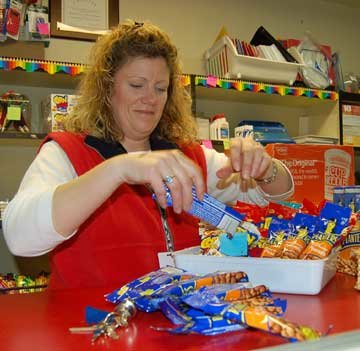This past fall the Key Peninsula Middle School PTSA decided to stop selling candy to students at the school’s student store. Diana Nole, PTSA president, explained, “Peninsula School District has guidelines stating that any item sold to students contain no more than 40 percent fat and/or 40 percent sugar. So, when I became PTSA president, though I was not required to follow these guidelines, I felt the snacks offered in the school store could be substituted by healthier choices. Mentos was our No. 1 seller before but since removing candy, now Gardetto’s (snack mix) is the top seller.”
 Diana Nole, KPMS PTA president, unloads the snacks for the student store. Photo by Mindi LaRose
Diana Nole, KPMS PTA president, unloads the snacks for the student store. Photo by Mindi LaRose
This is a growing trend throughout Washington, indeed nationally, that is spreading quickly. Diseases like type-2 diabetes, once only found in adults, are now being diagnosed at an alarming rate in children as young as 10 and 12. Along with physical ailments come mental anguish and stress, as overweight children struggle with peer pressure, self-image and trying to make healthy choices.
There are many examples of this trend in other public schools throughout the nation. Public schools in the state of Maine banned all “junk food” and soda. Their agreement defines junk food as “food that has minimal nutritional value and provides less than 5 percent of the daily allowance of eight nutrients per serving or 100 calories. The nutrients are iron, vitamin A, vitamin C, niacin, riboflavin, thiamin, calcium and iron.” That includes soda, but not drinks that contain fruit juices. It also includes chewing gum, hard candy, lollipops, mints, sugar wafers, jelly beans, candy-coated popcorn and gumdrops.
The Minneapolis School Board has battled with parents upset by a soda vending machine in a local elementary school. Some school board members advocate the selling of soda and candy as a way to raise funds for PTSA activities. However, the American Academy of Pediatrics, American Dental Association and even the American Beverage Group recommend a ban on soda pop and candy in schools.
At KPMS, some students support the decision, while others oppose the new rules. As one seventh grader points out, “Kids should be able to choose what they eat; if they want to put a bunch of candy into their bodies everyday, they should be able to. The choices we have now don’t really appeal to me or my friends.” An eighth grader, however, had a different point of view, stating, “There are too many kids our age that are unhealthy and overweight and just won’t make healthy choices no matter what.”
Some parents are happy to know the lunch money they send to school is being used to buy lunch and not handfuls of candy, as was sometimes the case when students could buy candy during the lunch breaks at the school store. Other parents, however, feel that middle school students should be responsible enough to make these choices for themselves.
UNDERWRITTEN BY THE FUND FOR NONPROFIT NEWS (NEWSMATCH) AT THE MIAMI FOUNDATION, THE ANGEL GUILD, ADVERTISERS, DONORS AND PEOPLE WHO SUPPORT INDEPENDENT, NONPROFIT LOCAL NEWS